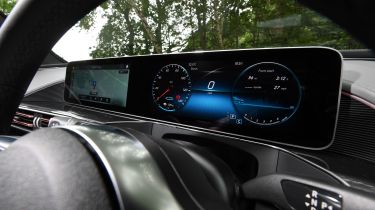Mercedes EQC review: performance, motor & drive
The Mercedes EQC has a different character to any of its rivals: it majors on comfort more than fun
| 0-62mph | Top speed | Driven wheels | Power |
|---|---|---|---|
| 5.1s | 110mph | Four | 402bhp |
With 402bhp and 765Nm of torque on tap, it’s no surprise that the EQC delivers gut-squirming mid-range speed. Even so, while it's fast enough by any standard, it doesn’t feel as punchy as a Jaguar I-Pace, let alone a Tesla Model X or the range-topping BMW iX. We’d like slightly more cohesive brake feel, too.
Comfort and refinement are clearly the priorities for the EQC; smooth, slick ride comfort – courtesy of the standard-fit, self-levelling air suspension system – and unexceptional if reassuringly neutral handling, are what really set it apart from its more enthusiastic-feeling alternatives. Rivalled only by the Audi Q8 e-tron, the EQC is quite simply one of the most cushty, relaxing cars in its class.
Mercedes EQC 0-62mph, top speed and acceleration
The EQC has a claimed 0-62mph time of 5.1 seconds, and while it feels incongruously rapid for such a heavy car, it never quite seems as quick as that sprint time suggests – rivals like the Model X and I-Pace feel faster still. For all that, nobody in their right mind would consider the EQC slow; it barrels up the road with enough brash mid-range urgency to make it a seriously rapid point-to-point car, while the linear, easy-to-modulate throttle response and power delivery also make it perfect for easing through a city commute.
Getting to grips with the brake regeneration is tricky. The EQC is set up to offer no regeneration in default Comfort mode when you turn it on, but you can use steering-wheel paddles to turn the function up or down. Holding the right-hand paddle down activates the automatic regeneration mode, which adjusts braking force to maximise the energy harvested and maintain distance from the car in front.
One frustration we have is the inconsistent feel of the brake pedal. If you rely mainly on the regenerative braking system you may not notice it all that much, but in faster driving or during an emergency stop, the pedal can feel a bit spongy. It’s a problem in a number of Merc’s electric cars – including the EQE and EQS flagships.
Handling
The EQC has a dual-motor setup: one on each axle to deliver four-wheel drive. It’s an active setup that sends all power to the more efficient front motor in normal driving, but if you ask for a surge of acceleration or encounter a slippery surface, the rear motor will kick in to give the best possible traction and stability.
Don’t go thinking the EQC is an off-roader, though. While its raised SUV stance and four-wheel-drive capability help with getting across a muddy yard or rutted track, this is very much an on-road SUV, so don’t expect it to cope well with anything more rugged. It’s no sporty SUV, either. This is a heavy car, and it feels it, so while you can select Sport mode and enjoy precise, secure-feeling progress when driving with intent down a decent road, it never feels as playful or exciting (beyond the vaguely shocking acceleration) as an I-Pace.
Comfort and refinement are the real strong points of the EQC – rivalling the Audi Q8 e-tron in this regard. But even by the remarkably high standards set by its peers, the Mercedes arguably has the best ride comfort and refinement in the class, with very little wind and tyre noise, and almost no whine from the electric motor. There’s no optional suspension, either; you get the excellent ride comfort as standard. It does a great job of easing you over scruffy road surfaces, and even sharp-edged potholes are soaked up with little more than a distant thump – even on the largest alloy wheels.




